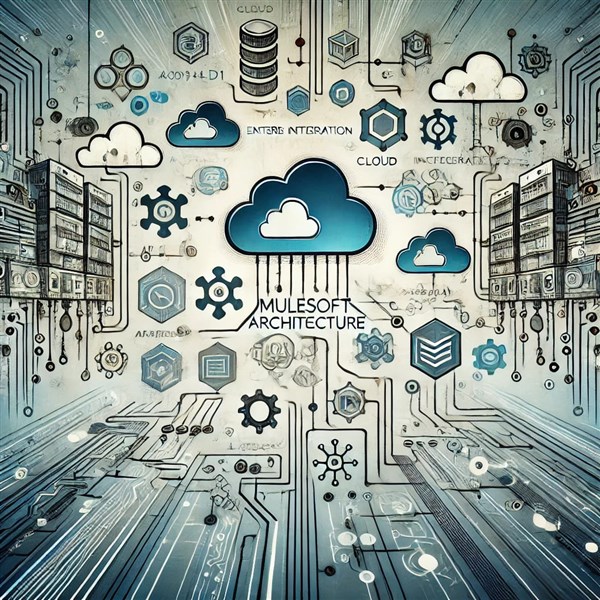We're open through the holidays to support your upskilling goals — book your session today!
We're open through the holidays to support your upskilling goals — book your session today!
Unable to find what you're searching for?
We're here to help you find it
In today’s fast-paced digital world, businesses rely on seamless integration between applications, databases, and cloud services to drive efficiency. Traditional integration methods often create data silos, inefficiencies, and security risks.
MuleSoft, a leader in integration and API management, provides a powerful architecture that simplifies data flow, API connectivity, and enterprise integration. Understanding the core components of MuleSoft architecture is essential for IT professionals, developers, and enterprises looking to modernize their integration strategy.
In this blog, we will explore:
✅ What MuleSoft architecture is
✅ Key components that make up MuleSoft’s integration ecosystem
✅ How these components work together to enable seamless connectivity
✅ Best practices for leveraging MuleSoft’s architecture for business success
By the end, you’ll have a deep understanding of MuleSoft’s architecture and how it can transform enterprise integration. 🚀
MuleSoft follows an API-led connectivity approach, allowing businesses to:
✔ Integrate applications, data, and devices seamlessly
✔ Connect cloud and on-premise systems efficiently
✔ Enable reusability of APIs and integrations
MuleSoft’s architecture is built on the Anypoint Platform, which offers a unified environment for designing, deploying, and managing APIs and integrations.
✔ Event-driven and API-first integration model
✔ Supports on-premise, cloud, and hybrid deployments
✔ Microservices and container-friendly
✔ Built-in security, monitoring, and analytics
Now, let’s break down the core components of MuleSoft architecture and how they work together.
MuleSoft’s architecture consists of several key components that enable scalability, security, and flexibility in enterprise integration.
The Anypoint Platform is the foundation of MuleSoft architecture, providing an end-to-end integration solution. It includes:
✔ API Manager – Controls and secures APIs
✔ Runtime Manager – Deploys and manages Mule applications
✔ Design Center – Develops APIs and integrations visually
✔ Anypoint Exchange – A marketplace for reusable assets
This platform acts as a centralized hub for designing, deploying, and managing integrations.
The Mule Runtime Engine is the core processing unit of MuleSoft that executes integration flows.
✔ Lightweight, Java-based engine
✔ Processes API requests and real-time data flows
✔ Supports batch processing for large data sets
✔ Event-driven architecture with asynchronous messaging
It ensures that data moves smoothly across systems while maintaining high performance.
MuleSoft follows a three-layer API architecture, enabling modular, reusable, and scalable integrations.
🔹 1. System APIs (Access data sources)
✔ Connect directly to databases, ERPs (SAP, Salesforce), and legacy systems
✔ Extract and expose raw data in a secure, scalable way
🔹 2. Process APIs (Transform and process data)
✔ Apply business logic and data transformation
✔ Enable orchestration between multiple System APIs
🔹 3. Experience APIs (Deliver user-friendly outputs)
✔ Customize API responses for web, mobile, or third-party apps
✔ Reduce the complexity of direct database access
This layered API approach ensures flexibility and reusability, reducing integration efforts and development time.
DataWeave is MuleSoft’s powerful data transformation language used for:
✔ Mapping and converting data formats (JSON, XML, CSV, etc.)
✔ Performing advanced data enrichment and validation
✔ Handling real-time and batch processing efficiently
With DataWeave, developers can easily manipulate structured and unstructured data to fit business needs.
Anypoint Exchange is a centralized marketplace for sharing and reusing integration assets. It provides:
✔ Pre-built API connectors (Salesforce, AWS, SAP, etc.)
✔ Reusable API fragments and best practices
✔ Accelerators and templates for rapid development
It enables collaboration and faster API deployment, reducing integration costs and efforts.
The API Manager is responsible for API security, governance, and analytics. It allows businesses to:
✔ Control API access using authentication (OAuth, JWT, etc.)
✔ Apply rate-limiting, throttling, and policies
✔ Monitor API usage and performance in real-time
With robust security and analytics, enterprises can ensure compliance and scalability.
The Runtime Manager provides a centralized dashboard to:
✔ Deploy, monitor, and troubleshoot Mule applications
✔ Manage on-premise, cloud, and hybrid environments
✔ Automate application scaling and recovery
It ensures high availability and performance optimization across integrations.
MuleSoft’s architecture integrates these components to create a streamlined, end-to-end data flow:
📌 Step 1: APIs are designed in Anypoint Design Center
📌 Step 2: Developers use DataWeave to transform and map data
📌 Step 3: APIs are deployed and secured using API Manager
📌 Step 4: Applications are monitored via Runtime Manager
📌 Step 5: Reusable API assets are shared in Anypoint Exchange
This structured API-led approach makes MuleSoft an industry leader in enterprise integration.
✔ Faster Integration Development – Pre-built connectors reduce manual effort
✔ Scalability & Flexibility – Supports cloud, on-premise, and hybrid models
✔ Security & Compliance – API Manager ensures governance and access control
✔ Business Agility – Enables rapid deployment and reusability of APIs
✔ Enhanced Performance – Mule Runtime Engine ensures high availability
By leveraging MuleSoft’s architecture, businesses can future-proof their integration strategy and maximize efficiency.
Conclusion
MuleSoft’s robust architecture provides a scalable, secure, and API-driven approach to enterprise integration. By using:
✔ Anypoint Platform for centralized management
✔ Mule Runtime Engine for fast processing
✔ API-led connectivity for modular and reusable integration
✔ DataWeave for seamless data transformation
Enterprises can unlock the full potential of their data and applications.
Koenig Solutions, a leading IT training company, offers comprehensive training courses on MuleSoft architecture. With a team of experienced trainers and a robust curriculum, Koenig Solutions provides an in-depth understanding of the core components of MuleSoft architecture. The training courses are designed to cater to both beginners and professionals, ensuring a holistic learning experience.
If you’re looking to enhance your integration skills, consider MuleSoft certification to master these core components and advance your IT career! 🚀

Aarav Goel has top education industry knowledge with 4 years of experience. Being a passionate blogger also does blogging on the technology niche.










